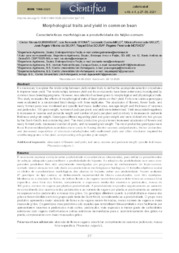Morphological traits and yield in common bean.
Morphological traits and yield in common bean.
Author(s): GUIMARÃES, C. M.; STONE, L. F.; MELO, L. C.; MELO, M. F. de; SILVA, J. A. V. da; SOUSA, R. S.; MORAES, R. P. de
Summary: It is necessary to explore the relationship between yield-related traits to define the appropriate selection procedures to improve bean yield. The relationships between yield and its components have been extensively investigated by common bean breeding programs. However, less attention has been given to morphological and physiological traits. This study evaluates the effects of morphological traits of bean plants on their yield. Forty-one carioca genotypes were evaluated in a randomized block design with three replicates. The abscission of flowers, flower buds, and newly formed pods was monitored and specific leaf mass, leaflet area, average length and thickness of racemes and peduncles, 100-grain weight, number of pods per plant, and yield were determined. Yield responded negatively to increases in raceme and peduncle length and number of pods per plant and positively to increases in peduncle thickness and grain weight. Genotypes differed regarding yield and grain weight and were divided into two groups by the Scott-Knott?s test considering yield. The most productive group showed increased abscission of flowers and newly formed pods, decreased number of pods, and increased grain weight. The most productive genotypes were those that remobilized photoassimilates more easily for having shorter racemes and peduncles, thicker peduncles, and decreased expenditure of structural carbohydrates with malformed pods and other structures required for conditioning grains in the plant, compensating with greater grain weight.
Publication year: 2021
Types of publication: Journal article
Unit: Embrapa Rice & Beans
Observation
Some of Embrapa's publications are published as ePub files. To read them, use or download one of the following free software options to your computer or mobile device. Android: Google Play Books; IOS: iBooks; Windows and Linux: Calibre.
Access other publications
Access the Agricultural Research Database (BDPA) to consult Embrapa's full library collection and records.
Visit Embrapa Bookstore to purchase books and other publications sold by Embrapa.

